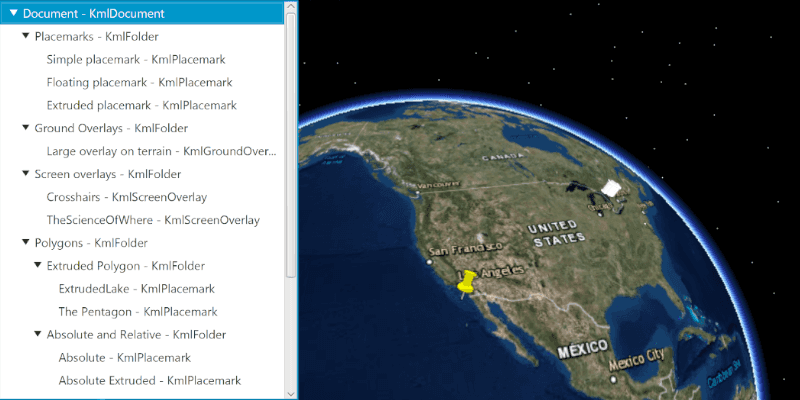List the contents of a KML file.

Use case
KML files can contain a hierarchy of features, including network links to other KML content. A user may wish to traverse through the contents of KML nodes to know what data is contained within each node and, recursively, their children.
How to use the sample
The contents of the KML file are shown in a tree. Select a node to zoom to that node. Not all nodes can be zoomed to (e.g. screen overlays).
How it works
- Add the KML file to the scene as a layer.
- Explore the root nodes of the
KmlDatasetrecursively explored to create a view model.
- Each node is enabled for display at this step. KML files may include nodes that are turned off by default.
- When a node is selected, get its extent with selectedNode.getExtent(). Use that to create a
Viewpointand set theSceneViewobject's viewpoint to it.
Relevant API
- KmlContainer
- KmlDataset
- KmlDocument
- KmlFolder
- KmlGroundOverlay
- KmlLayer
- KmlNetworkLink
- KmlNode
- KmlPlacemark
- KmlScreenOverlay
Tags
Keyhole, KML, KMZ, layers, OGC
Sample Code
ListKMLContentsSample.java
/*
* Copyright 2018 Esri.
*
* Licensed under the Apache License, Version 2.0 (the "License"); you may not
* use this file except in compliance with the License. You may obtain a copy of
* the License at
*
* http://www.apache.org/licenses/LICENSE-2.0
*
* Unless required by applicable law or agreed to in writing, software
* distributed under the License is distributed on an "AS IS" BASIS, WITHOUT
* WARRANTIES OR CONDITIONS OF ANY KIND, either express or implied. See the
* License for the specific language governing permissions and limitations under
* the License.
*/
package com.esri.samples.list_kml_contents;
import java.io.File;
import java.util.ArrayList;
import java.util.List;
import javafx.application.Application;
import javafx.geometry.Insets;
import javafx.geometry.Pos;
import javafx.scene.Scene;
import javafx.scene.control.TreeItem;
import javafx.scene.control.TreeView;
import javafx.scene.control.cell.TextFieldTreeCell;
import javafx.scene.layout.StackPane;
import javafx.stage.Stage;
import javafx.util.StringConverter;
import com.esri.arcgisruntime.ArcGISRuntimeEnvironment;
import com.esri.arcgisruntime.geometry.Envelope;
import com.esri.arcgisruntime.layers.KmlLayer;
import com.esri.arcgisruntime.mapping.ArcGISScene;
import com.esri.arcgisruntime.mapping.BasemapStyle;
import com.esri.arcgisruntime.mapping.Viewpoint;
import com.esri.arcgisruntime.mapping.view.SceneView;
import com.esri.arcgisruntime.ogc.kml.KmlContainer;
import com.esri.arcgisruntime.ogc.kml.KmlDataset;
import com.esri.arcgisruntime.ogc.kml.KmlDocument;
import com.esri.arcgisruntime.ogc.kml.KmlFolder;
import com.esri.arcgisruntime.ogc.kml.KmlGroundOverlay;
import com.esri.arcgisruntime.ogc.kml.KmlNetworkLink;
import com.esri.arcgisruntime.ogc.kml.KmlNode;
import com.esri.arcgisruntime.ogc.kml.KmlPlacemark;
import com.esri.arcgisruntime.ogc.kml.KmlScreenOverlay;
public class ListKMLContentsSample extends Application {
private SceneView sceneView;
@Override
public void start(Stage stage) {
try {
// create stack pane and application scene
StackPane stackPane = new StackPane();
Scene fxScene = new Scene(stackPane);
// set title, size, and add scene to stage
stage.setTitle("List KML Contents Sample");
stage.setWidth(800);
stage.setHeight(700);
stage.setScene(fxScene);
stage.show();
// authentication with an API key or named user is required to access basemaps and other location services
String yourAPIKey = System.getProperty("apiKey");
ArcGISRuntimeEnvironment.setApiKey(yourAPIKey);
// create a scene add it to the scene view
ArcGISScene scene = new ArcGISScene(BasemapStyle.ARCGIS_IMAGERY);
sceneView = new SceneView();
sceneView.setArcGISScene(scene);
// load a KML dataset from a local KMZ file and show it as an operational layer
File kmzFile = new File(System.getProperty("data.dir"), "./samples-data/kml/esri_test_data.kmz");
KmlDataset kmlDataset = new KmlDataset(kmzFile.getAbsolutePath());
KmlLayer kmlLayer = new KmlLayer(kmlDataset);
scene.getOperationalLayers().add(kmlLayer);
// create a tree view to list the contents of the KML dataset
TreeView<KmlNode> kmlTree = new TreeView<>();
kmlTree.setMaxSize(300, 400);
TreeItem<KmlNode> root = new TreeItem<>(null);
kmlTree.setRoot(root);
kmlTree.setShowRoot(false);
// when the dataset is loaded, recursively build the tree view with KML nodes starting with the root node(s)
kmlDataset.addDoneLoadingListener(() -> kmlDataset.getRootNodes().forEach(kmlNode -> {
TreeItem<KmlNode> kmlNodeTreeItem = buildTree(new TreeItem<>(kmlNode));
root.getChildren().add(kmlNodeTreeItem);
}));
// show the KML node in the tree view with its name and type
kmlTree.setCellFactory(param -> new TextFieldTreeCell<>(new StringConverter<KmlNode>() {
@Override
public String toString(KmlNode node) {
String type = null;
if (node instanceof KmlDocument) {
type = "KmlDocument";
} else if (node instanceof KmlFolder) {
type = "KmlFolder";
} else if (node instanceof KmlGroundOverlay) {
type = "KmlGroundOverlay";
} else if (node instanceof KmlScreenOverlay) {
type = "KmlScreenOverlay";
} else if (node instanceof KmlPlacemark) {
type = "KmlPlacemark";
}
return node.getName() + " - " + type;
}
@Override
public KmlNode fromString(String string) {
return null; //not needed
}
}));
// when a tree item is selected, zoom to its node's extent (if it has one)
kmlTree.getSelectionModel().selectedItemProperty().addListener(o -> {
TreeItem<KmlNode> selectedTreeItem = kmlTree.getSelectionModel().getSelectedItem();
KmlNode selectedNode = selectedTreeItem.getValue();
Envelope nodeExtent = selectedNode.getExtent();
if (nodeExtent != null && !nodeExtent.isEmpty()) {
sceneView.setViewpointAsync(new Viewpoint(nodeExtent));
}
});
// add the map view to stack pane
stackPane.getChildren().addAll(sceneView, kmlTree);
StackPane.setAlignment(kmlTree, Pos.TOP_LEFT);
StackPane.setMargin(kmlTree, new Insets(10));
} catch (Exception e) {
// on any error, display the stack trace.
e.printStackTrace();
}
}
/**
* Recursively adds child tree items to the given parent tree item based on its node's child nodes.
*
* @param parent a parent KML node tree item
* @return the original parent, now with the child tree attached to it
*/
private TreeItem<KmlNode> buildTree(TreeItem<KmlNode> parent) {
KmlNode node = parent.getValue();
node.setVisible(true);
List<KmlNode> children = new ArrayList<>();
if (parent.getValue() instanceof KmlContainer) {
children.addAll(((KmlContainer) node).getChildNodes());
} else if (parent.getValue() instanceof KmlNetworkLink) {
children.addAll(((KmlNetworkLink) node).getChildNodes());
}
children.forEach(childNode -> {
TreeItem<KmlNode> childTreeItem = buildTree(new TreeItem<>(childNode));
parent.getChildren().add(childTreeItem);
});
parent.setExpanded(true); // expand all nodes in the tree view
return parent;
}
/**
* Stops and releases all resources used in application.
*/
@Override
public void stop() {
if (sceneView != null) {
sceneView.dispose();
}
}
/**
* Opens and runs application.
*
* @param args arguments passed to this application
*/
public static void main(String[] args) {
Application.launch(args);
}
}